Experimental Case Studies about Uniplanar SHS Joints with Full-Overlapped Top Connection
Abstract
:1. Introduction
2. Materials and Methods
3. Results
3.1. Maximum Compression Force SHS
3.2. Comparison between SHS and CHS
4. Discussion
5. Conclusions
- The inclination angle of the braces has a large influence on the resistance of the welded joints. If the inclination angle increases, the resistance of the joint will decrease significantly. The resistance reduction is around 46% for an increase in inclination of 25°, around 2 percent per one degree; there is reduction when comparing the 20° and 45° models.
- The behavior of the resistance regarding the different inclination angle systems is not linear. There is a larger effect concerning the extreme angles of 20° and 45°. The results of the 25° and 30° systems are similar. In future studies, more steps regarding the inclination angle in the range of 20° to 45° will be analyzed.
- The joint made of the squared hollow section profile has a higher resistance compared to the circular hollow section profile joints. The SHS resistance is higher compared to joints made of circular profiles, including the same or smaller profile thicknesses. This conclusion is valid for the joints with the geometrical parameters presented in this paper.
- By comparing the results of the SHS and CHS models concerning the maximal applicable force, differences occur. The differences are 32 kN between the SHS and CHS and 2.8 mm and 21 kN between the CHS 2.0 mm and CHS 2.8 mm models. These values are averages. These differences of the results are nearly constant independent of the inclination angle.
- There is good agreement between the numerical and experimental results. Using a refined mesh with solid elements, the differences of the numerical and experimental results are between 9% and 20%. These differences are explainable by small welding imperfections.
- If the inclination angle increases, the strains at relevant positions will decrease. The numerical and experimental tests show that these relevant positions are generally located at the welding line and at the pipes close to the welding line. In particular, higher strains arise at the flat surface of the pipe, close to the edges of the square hollow section.
Author Contributions
Funding
Institutional Review Board Statement
Informed Consent Statement
Data Availability Statement
Acknowledgments
Conflicts of Interest
References
- Tan, K.H.; Fung, T.C.; Nguyen, M.P. Structural behavior of CHS T-joints subjected to brace axial compression in fire condition. J. Struct. Eng. 2013, 139, 73–84. [Google Scholar] [CrossRef]
- DIN EN 1993-1-8; Eurocode 3, Bemessung und Konstruktion von Stahlbauten—Bemessung von Anschlüssen, 2010–2012. Deutsches Institut für Normung: Berlin, Germany, 2010.
- Wardenier, J.; Kurobane, Y.; Packer, J.A.; Van der Vegte, G.J.; Zhao, X.L. Design guide for circular hollow section (CHS) connection under predominantly static loading. In Construction with Hollow Sections; Serial No. 1; CIDECT: Geneva, Switzerland, 1991. [Google Scholar]
- Heinemann, P.; Isopescu, D.N.; Maxineasa, S.G. Numerical case study about three-dimensional CHS joints with overlapped top connection. In Proceedings of the CNCM17: XVII National Conference of Metal Constructions, Bucharest, Romania, 28–29 October 2021. [Google Scholar]
- Heinemann, P.; Isopescu, D.N.; Maxineasa, S.G. FEM Analysis for the behavior of two-dimensional CHS joints with asymmetrical Full-Overlapped top-connection. Mater. Today Proc. 2021, 58, 1155–1161. [Google Scholar] [CrossRef]
- Heinemann, P.; Isopescu, D.N.; Maxineasa, S.G. Case studies on finite element modelling of welded joints. Bull. Polytech. Inst. Jassy Constr. Archit. Sect. 2021, 71, 79–94. [Google Scholar]
- Heinemann, P.; Isopescu, D.N.; Maxineasa, S.G. Numerical case studies about two-dimensional SHS joints with symmetrical and asymmetrical top-connection. In Proceedings of the 16th International Scientific Conference: Civil Engineering and Building Services (CIBv 2021), Brașov, Romania, 4–5 November 2021. [Google Scholar]
- Heinemann, P.; Isopescu, D.-N. Numerical Case Studies about Two-Dimensional CHS Joints with Symmetrical Full-Overlapped Top-Connection. Materials 2022, 15, 3333. [Google Scholar] [CrossRef] [PubMed]
- Podkoritovs, A.; Serdjuks, D.; Goremikins, V.; Buka-Vaivade, K.; Kirsanov, M.N. Behavior of a space inverted triangular steel truss. Balt. J. Road Bridge Eng. 2020, 15, 54–70. [Google Scholar] [CrossRef]
- Talabani, S.S.; Azeez, A.T.; Barros, S.D.; Fadhil, B.M.; Omer, H.H. Effect of Modelling Techniques on the Simulation: Calculating the Stress Concentration Factors in Square Hollow Section T-Joints as a Case Study. ARO-Sci. J. Koya Univ. 2020, VIII, ARO.10585. [Google Scholar]
- Radić, I.; Markulak, D.; Mikolin, M. Design and FEM Modelling od steel Truss Girder Joints. Strojarstvo 2010, 52, 125–135. [Google Scholar]
- Kalač, Š.; Zejnelagić, N.; Đuričić, Đ.; Lučić, D. Proposal of analytical expression for determination of load capacity for aluminum square hollow section (SHS) K Joint under chord tension. In Proceedings of the 8th International Conference “Civil Engineering—Science and Practice” GNP, Kolašin, Montenegro, 8–12 March 2022. [Google Scholar]
- Dawod, B.M.; Safar, S.S. Experimental and Numerical Investigation on Strength of Eccentrically Loaded Steel Square Hollow Sections. Des. Eng. 2021, 6, 2638–2656. [Google Scholar]
- Soni, V.; Chandrakar, V.K.S.; Tomar, P.S. Experimental Study of Connection for Squared Hollow Beam and Column. Int. J. Sci. Res. Dev. 2018, 5, 915–917. [Google Scholar]
- EN 10219-2; Cold Formed Welded Steel Structural Hollow Sections—Part 2: Tolerances, Dimensions and Sectional Properties. Deutsches Institut für Normung: Berlin, Germany, 2019.
- Heinemann, P.; Isopescu, D.N.; Maxineasa, S.G. The influence of materials on the behavior of joints with multiple bar connections. In IOP Conference Series: Materials Science and Engineering, Proceedings of the 15th International Scientific Conference CIBv—Civil Engineering and Building Services, Brașov, Romania, 5–6 November 2020; IOP Publishing Ltd.: Bristol, England, 2021; Volume 1138, p. 012023. [Google Scholar]
- Younise, B.; Rakin, M.; Gubeljak, N.; Međo, B.; Sedmak, A. Numerical prediction of ductile fracture resistance of welded joint zones. Procedia Struct. Integr. 2016, 2, 753–760. [Google Scholar] [CrossRef] [Green Version]
- Konjatić, P.; Katinić, M.; Kozak, D.; Gubeljak, N. Yield Load Solutions for SE(B) Fracture Toughness Specimen with I-Shaped Heterogeneous Weld. Materials 2022, 15, 214. [Google Scholar] [CrossRef]
- Saini, D.S.; Karmakar, D.; Ray-Chaudhuri, S. A review of stress concentration factors in tubular and non-tubular joints for design of offshore installations. J. Ocean Eng. Sci. 2016, 1, 186–202. [Google Scholar] [CrossRef] [Green Version]
- Heinemann, P.; Isopescu, D.N.; Maxineasa, S.G. Study on the modelling of crack propagation in the joints of tubular steel elements. Bull. Polytech. Inst. Jassy Constr. Archit. Sect. 2020, 66, 79–94. [Google Scholar]
- Atteya, M.; Mikkelsen, O.; Lemu, H.G. State-of-the-art of crack propagation modelling in tubular joints. In Proceedings of the 2nd Conference of Computational Methods in Offshore Technology and First Conference of Oil and Gas Technology (COTech & OGTech 2019), Stavanger, Norway, 27–29 November 2019; Volume 700, p. 012035. [Google Scholar]
- Al-Mukhtar, M.A. Fracture Simulation of Welded Joint; Nova Science Publishers: Hauppauge, NY, USA, 2011; ISBN 978-1-61470-799-8. [Google Scholar]
- Doncheva, E.; Medjo, B.; Rakin, M.; Sedmak, S.; Trajanoska, B. Numerical simulation of crack propagation in high-strength low-alloyed welded steel. Procedia Struct. Integr. 2018, 13, 483–488. [Google Scholar] [CrossRef]
- Zwick Roell Measuring Machines. Available online: https://www.zwickroell.com/ (accessed on 7 March 2022).
- Teflon Plates, Material: Polytetrafluorethylene (PTFE). Available online: https://www.teflon.de/ (accessed on 7 March 2022).
- Heinemann, P.; Isopescu, D.-N. Experimental and Numerical Case Studies about Two-Dimensional CHS Joints with a Symmetrical Y-Shape. Materials 2022, 15, 3179. [Google Scholar] [CrossRef]
- ANSYS Inc. Products 2019 R3© 2006–2019, Software Application. Available online: https://www.ansys.com/ (accessed on 27 April 2022).
- Efthymiou, M. Local Rotational Stiffness of Unstiffened Tubular Joints; KSEPL Report RKER 85; Koninklijke Shell Exploratie en Produktie Laboratorium: Rijswijk, The Netherlands, 1985; p. 199. [Google Scholar]
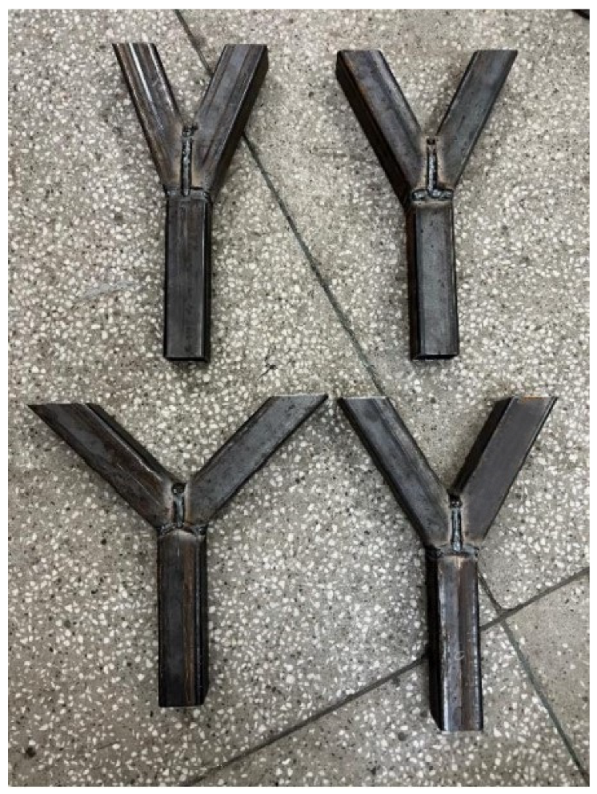
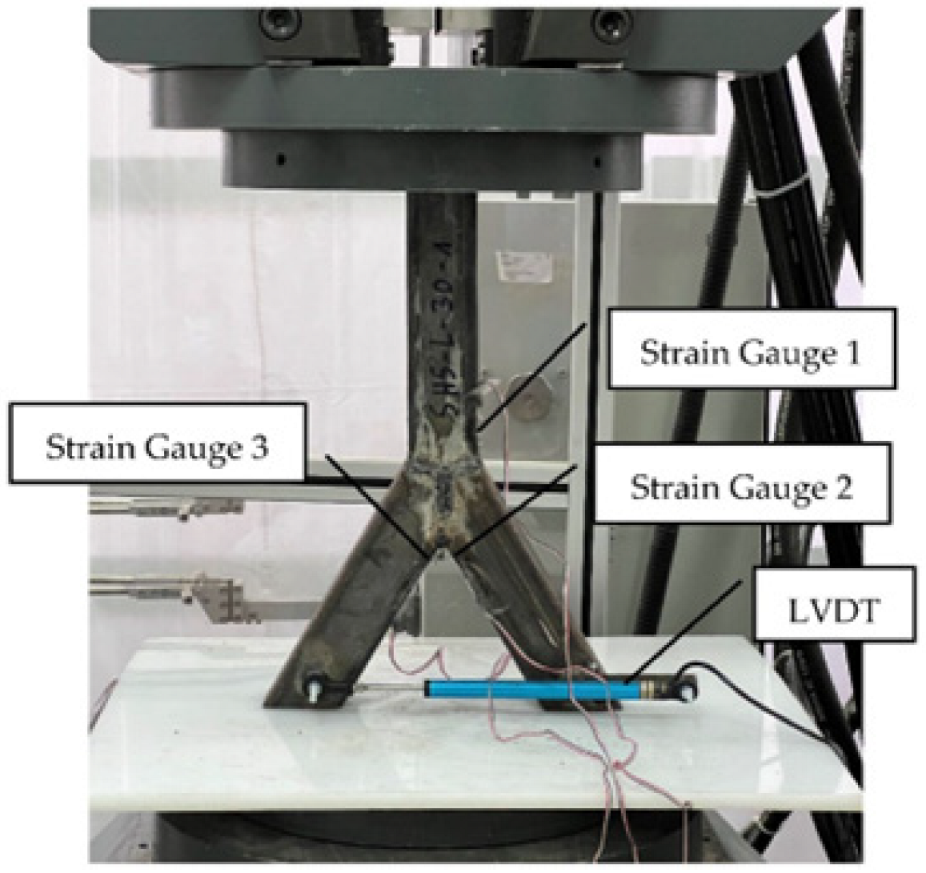
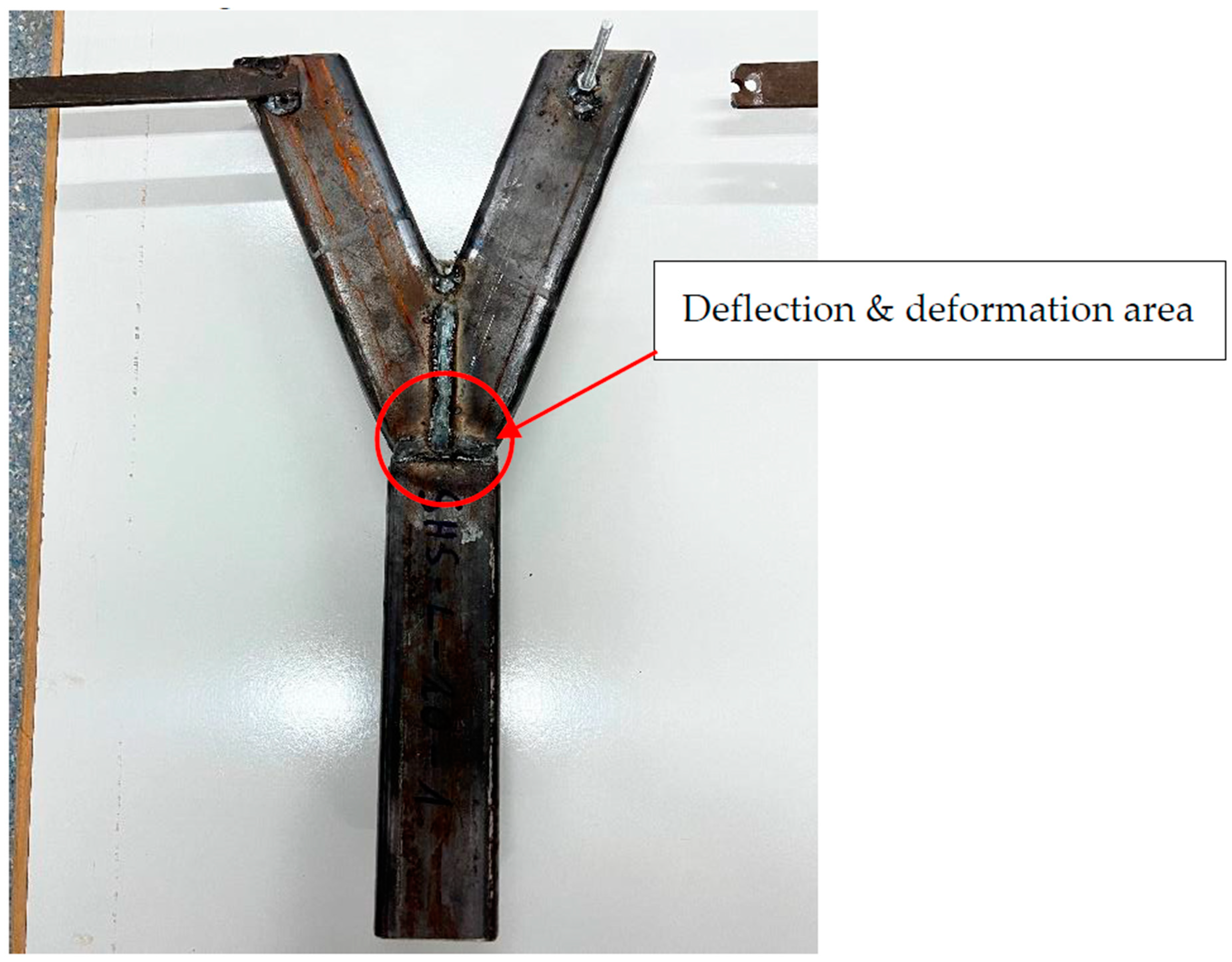

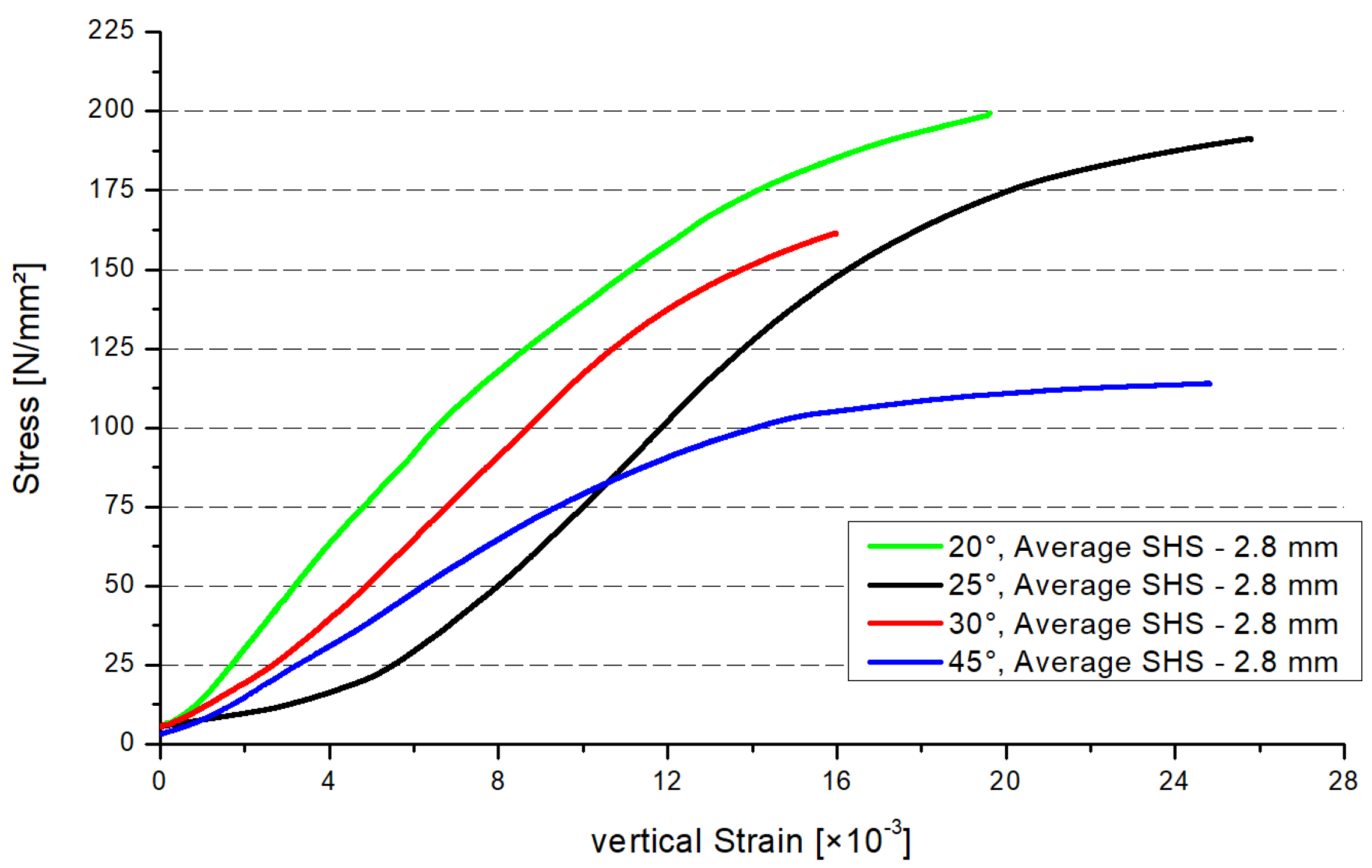
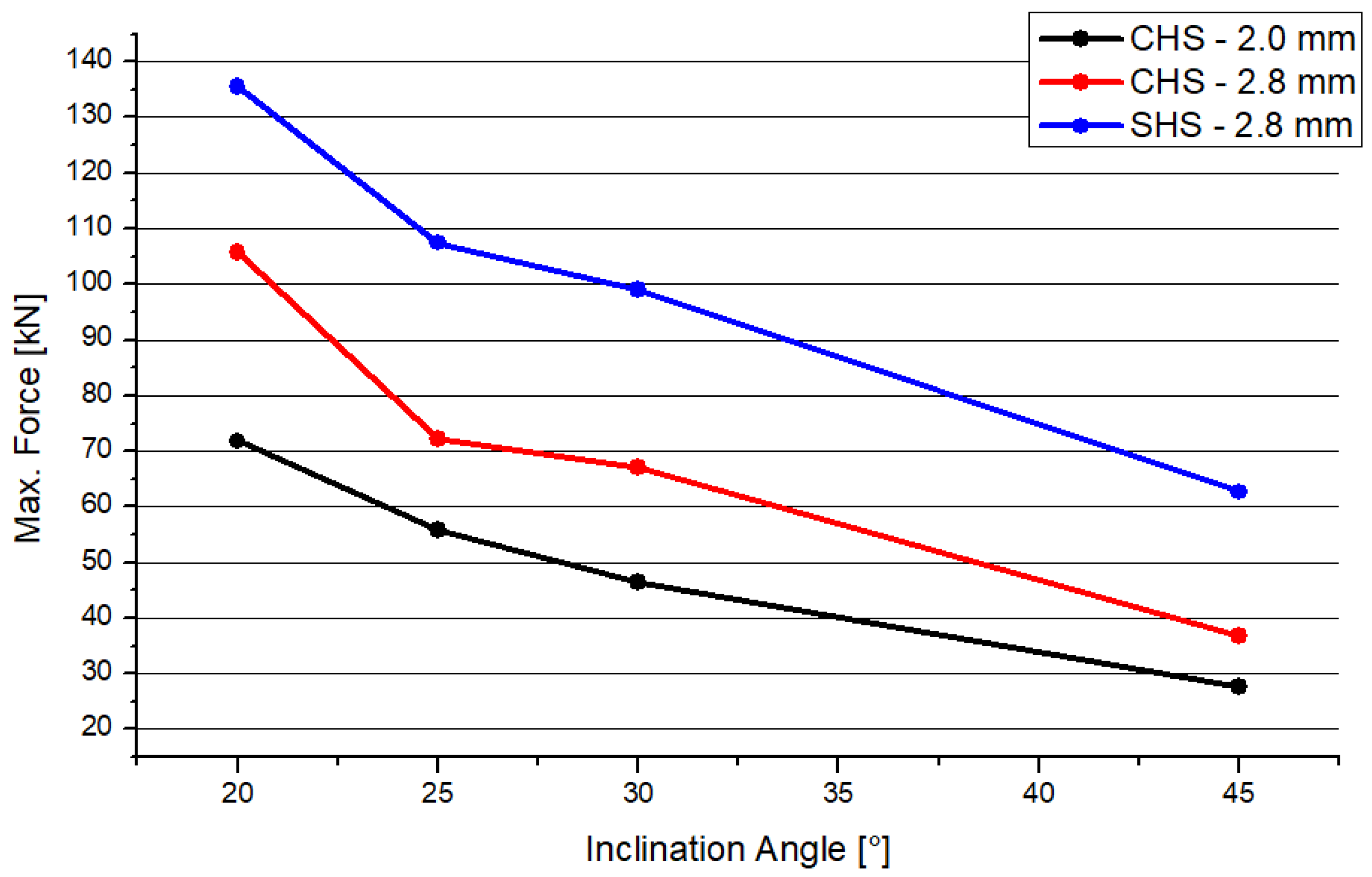
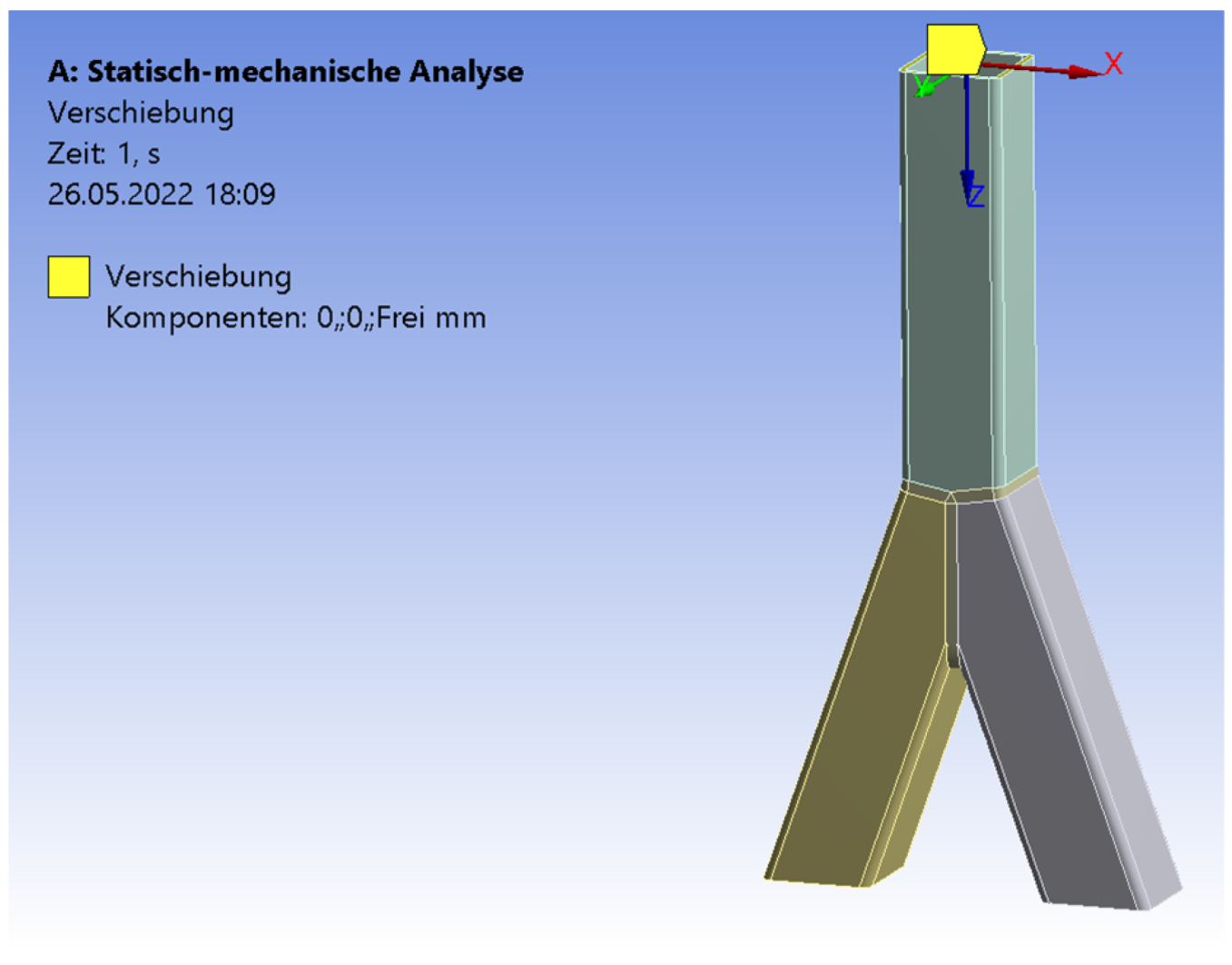
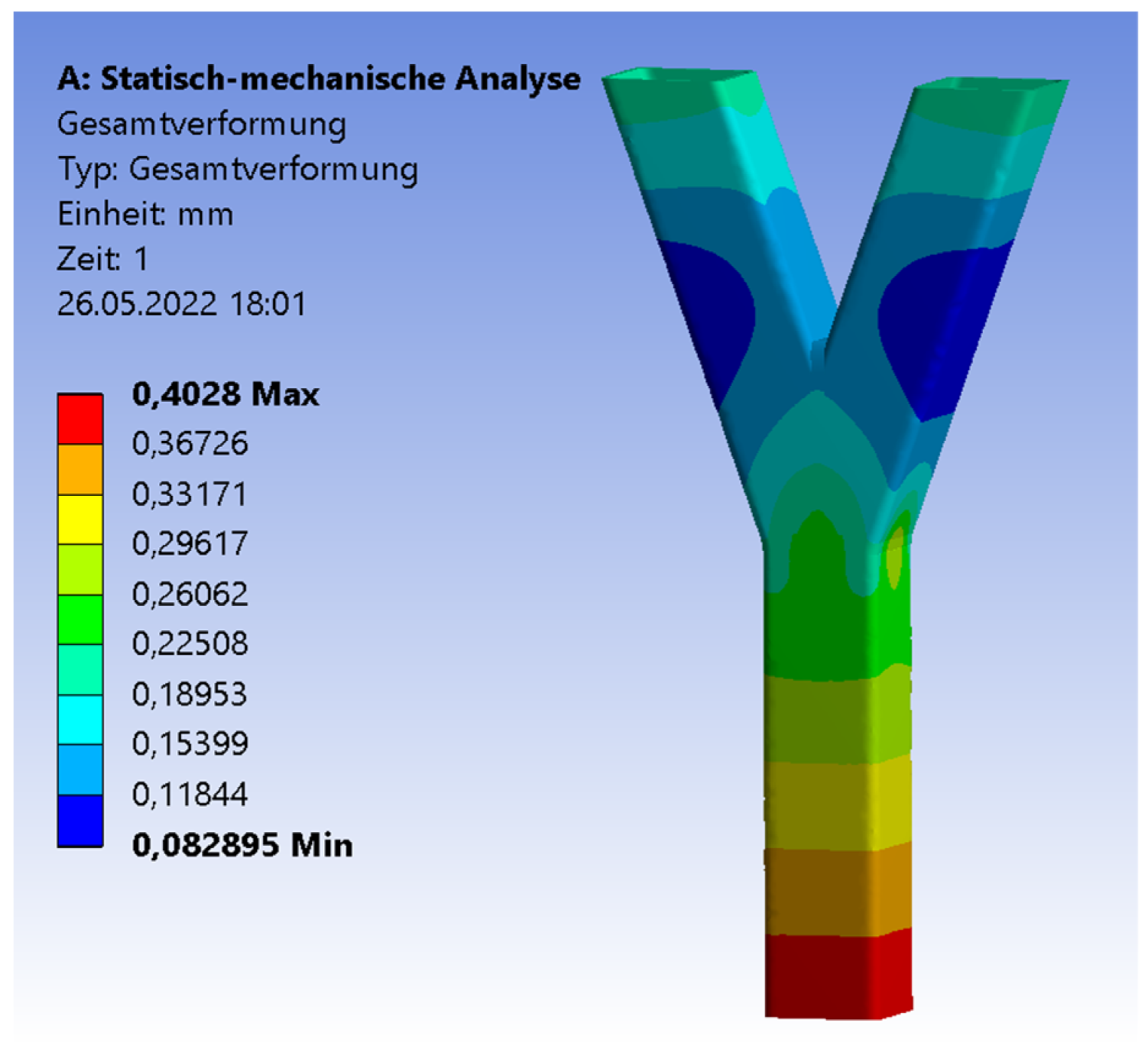
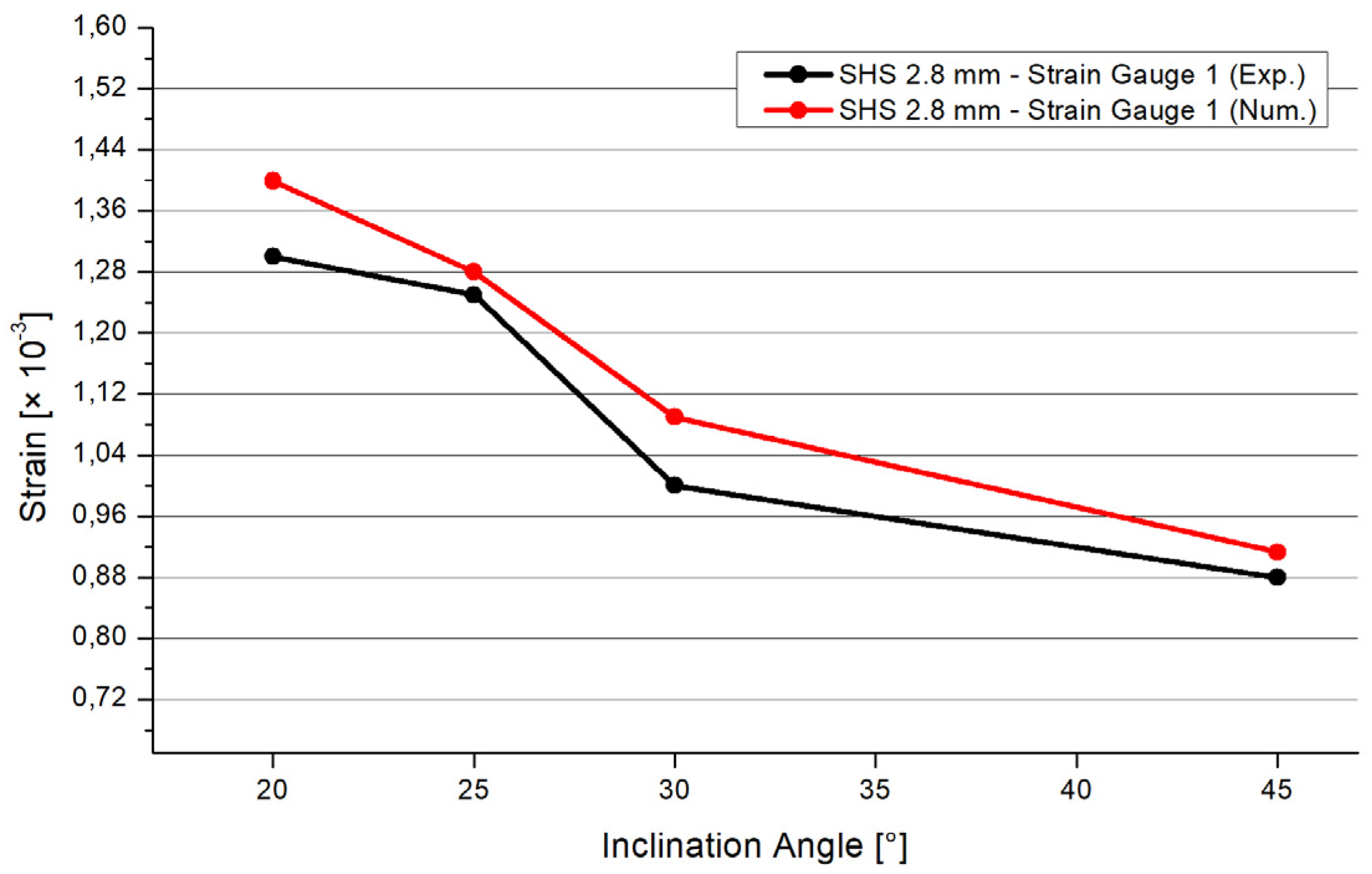

Publisher’s Note: MDPI stays neutral with regard to jurisdictional claims in published maps and institutional affiliations. |
© 2022 by the authors. Licensee MDPI, Basel, Switzerland. This article is an open access article distributed under the terms and conditions of the Creative Commons Attribution (CC BY) license (https://creativecommons.org/licenses/by/4.0/).
Share and Cite
Heinemann, P.; Isopescu, D.-N. Experimental Case Studies about Uniplanar SHS Joints with Full-Overlapped Top Connection. Materials 2022, 15, 4089. https://doi.org/10.3390/ma15124089
Heinemann P, Isopescu D-N. Experimental Case Studies about Uniplanar SHS Joints with Full-Overlapped Top Connection. Materials. 2022; 15(12):4089. https://doi.org/10.3390/ma15124089
Chicago/Turabian StyleHeinemann, Patrick, and Dorina-Nicolina Isopescu. 2022. "Experimental Case Studies about Uniplanar SHS Joints with Full-Overlapped Top Connection" Materials 15, no. 12: 4089. https://doi.org/10.3390/ma15124089
APA StyleHeinemann, P., & Isopescu, D.-N. (2022). Experimental Case Studies about Uniplanar SHS Joints with Full-Overlapped Top Connection. Materials, 15(12), 4089. https://doi.org/10.3390/ma15124089






